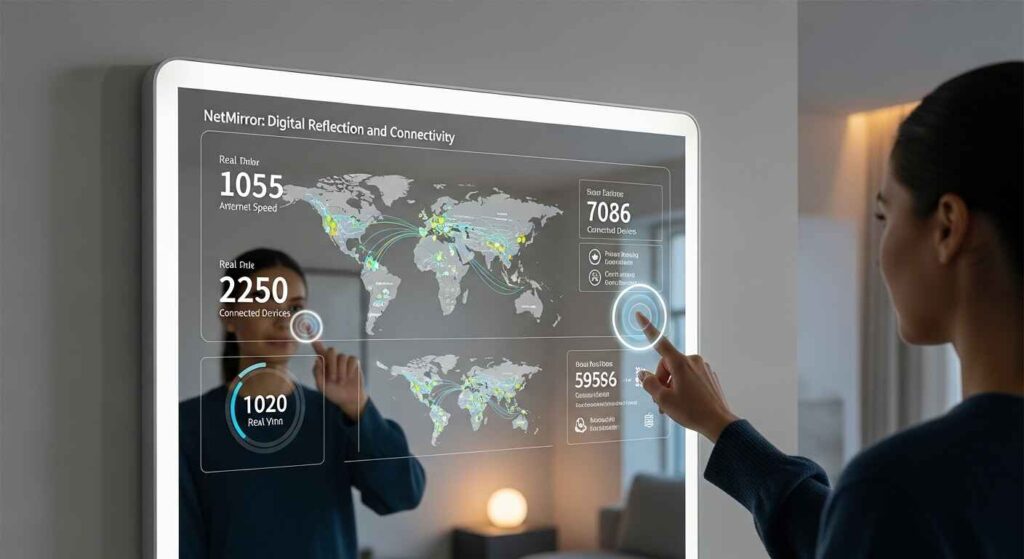Introduction
In the fast-paced digital world, staying connected and monitoring online activities has become essential. NetMirror is a term that represents a powerful concept in digital reflection, synchronization, and monitoring across various devices and platforms.
Whether for business, education, or personal use, NetMirror plays an important role in how we share, manage, and view data in real time.
This article explains what NetMirror is, how it works, and why it is becoming increasingly relevant in today’s connected environment.
What Is NetMirror?

NetMirror refers to a system or platform that mirrors digital content, screens, or data across multiple devices using the internet. It allows users to display, control, and share information seamlessly between computers, smartphones, or other networked devices.
In simple terms, NetMirror acts as a “digital mirror,” showing what’s happening on one device across others in real-time. This makes it useful for remote work, online education, tech support, and business management.
How Does NetMirror Work?
At its core, NetMirror functions through real-time synchronization. When a user performs an action on one device, that data is transmitted over the network and displayed on connected devices. This can be achieved through secure cloud-based systems, local network setups, or screen-sharing technologies.
Key Components of NetMirror Technology
- Data Synchronization – Ensures updates and changes are reflected instantly on all connected devices.
- Cloud Connectivity – Uses secure cloud services to transmit and store mirrored data.
- Encryption Protocols – Protects sensitive data during transmission.
- User Interface (UI) – Provides a simple dashboard to manage devices and content.
These features make NetMirror a practical and efficient solution for individuals and organizations that need real-time collaboration and monitoring.
Applications of NetMirror in Everyday Life
NetMirror technology is versatile and can be used in several areas of modern life. Below are some common applications:
1. Business Collaboration
Companies use NetMirror tools for meetings, presentations, and project coordination. Employees can share screens, discuss updates, and edit files simultaneously without being in the same location.
2. Education and E-Learning
Teachers and students can use NetMirror systems to display lessons, share materials, and engage in interactive sessions. It creates a virtual classroom experience that supports hybrid learning environments.
3. Customer Support
Technical support teams can remotely view a user’s screen using NetMirror solutions. This allows them to diagnose and fix problems faster, improving customer satisfaction.
4. Personal Device Management
Individuals use NetMirror to connect smartphones, tablets, and PCs. It enables users to manage notifications, transfer files, and mirror apps conveniently.
5. Security and Monitoring
NetMirror can also be used in surveillance and monitoring systems, allowing users to watch live feeds and analyze activity across different cameras or sensors in real-time.
Benefits of Using NetMirror
The growing adoption of NetMirror technology is due to its many benefits that enhance efficiency and connectivity. Here are some of the key advantages:
1. Real-Time Access
NetMirror enables immediate access to data and visuals from any connected device, ensuring quick response times and smooth workflow.
2. Improved Collaboration
Team members can work together from anywhere in the world, promoting teamwork and productivity without physical limitations.
3. Enhanced Security
Modern NetMirror platforms come with encrypted connections and access controls that ensure data privacy and safety.
4. Cost Efficiency
By using NetMirror, organizations can reduce travel and infrastructure costs since employees can work remotely and still stay connected.
5. Easy Integration
NetMirror tools are designed to integrate easily with existing systems, whether it’s a corporate network or personal device setup.
NetMirror in the Business World
In the corporate environment, NetMirror is transforming how teams operate. With hybrid work becoming the norm, businesses rely on NetMirror systems to bridge the gap between remote and in-office employees.
1. Remote Work Support
Through NetMirror, employees can share their work progress and screens instantly, keeping everyone updated and aligned with company goals.
2. Data Analytics and Reporting
Some NetMirror tools include advanced analytics features that provide insights into performance, system usage, and productivity trends.
3. Better Communication
By mirroring data and visuals, teams experience clearer communication, which helps avoid misunderstandings during projects and meetings.
How NetMirror Enhances Learning Environments
In education, NetMirror serves as a bridge between teachers and students. With online learning platforms becoming essential, mirroring technology ensures interactive and engaging lessons.
1. Interactive Classrooms
Students can view the teacher’s screen on their devices, follow lessons in real time, and even participate in group activities.
2. Recording and Review
NetMirror systems allow sessions to be recorded for later viewing, helping students revise and understand complex topics.
3. Accessibility for All
It provides equal access to digital materials for students regardless of location or device type, supporting inclusivity in education.
Challenges and Limitations of NetMirror
While NetMirror offers several advantages, it also comes with challenges that users must consider.
1. Network Dependency
The performance of NetMirror depends heavily on internet connectivity. Poor connections can cause delays or interruptions.
2. Data Privacy Risks
If not properly secured, mirrored data may be exposed to unauthorized access. Users must ensure encryption and authentication are enabled.
3. Device Compatibility
Not all devices support every NetMirror feature. Compatibility between operating systems can sometimes be an issue.
Future of NetMirror Technology
As technology advances, NetMirror will continue to evolve. Innovations in artificial intelligence, cloud computing, and cybersecurity are expected to make NetMirror more reliable and powerful.
1. AI Integration
Artificial intelligence will enhance NetMirror by automating monitoring, detecting issues, and providing intelligent feedback.
2. 5G and Faster Connectivity
With 5G networks, NetMirror will deliver faster and smoother performance, even for high-definition content sharing.
3. Smart Device Expansion
NetMirror will integrate with smart home systems, wearables, and IoT devices, offering more connected experiences in daily life.
Why NetMirror Matters in the Digital Age

In a world driven by data and connectivity, NetMirror is more than just a technical tool — it’s a necessity. It allows seamless collaboration, instant access to information, and improved communication between individuals and organizations.
By integrating NetMirror into business operations, education systems, and personal devices, users gain better control and visibility over their digital environment.
Conclusion
NetMirror represents the future of connected digital experiences. Its ability to mirror, synchronize, and manage data in real-time makes it a vital tool for businesses, educators, and individuals alike. As technology continues to grow, NetMirror will play an even greater role in shaping the way we communicate, collaborate, and share information.
Whether you’re managing a business, teaching online, or simply organizing your personal devices, NetMirror provides the efficiency and connectivity needed in today’s fast-moving digital world.


